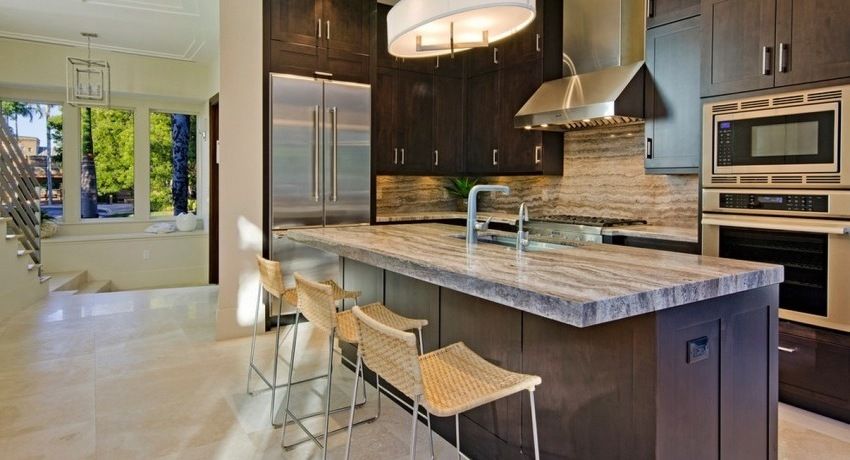The text considers such type of devices as cable channels: dimensions and design of structures, product classification according to the main characteristics (material, configuration, design, structure), advantages and scope of their application, as well as additional accessories. The text contains a brief overview of popular manufacturers, average prices for cable channels and recommendations on the choice of these products.
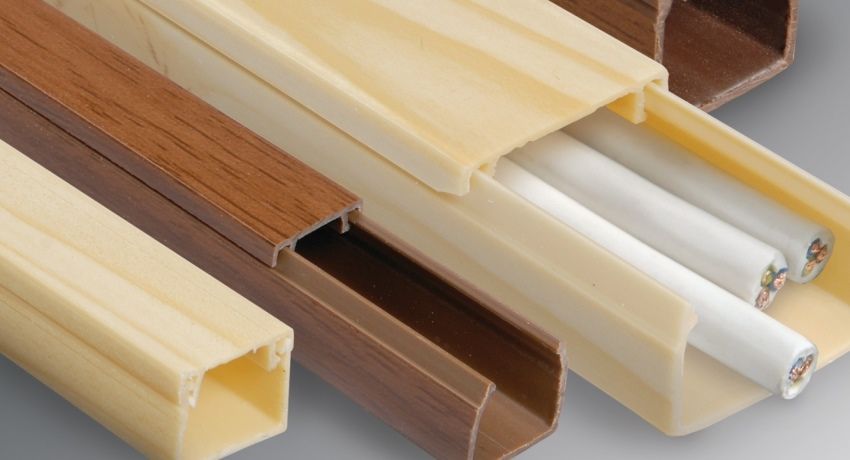
Device and types of cable channels for electrical wiring: types, prices of products
The cable channel is a box for wiring, made in the form of a closed profile. In most cases, the products have a triangular or rectangular shape, although there are other options. The design consists of a metal or plastic box, as well as a cover. The product is fixed on the surface in various ways.

For installation are used:
- rivets;
- self-tapping screws;
- special glue;
- screws, etc.
After the product is installed and secured, the cables are laid into the channels and then the cover closes. Due to the special design, all parts of the fixture are held securely, so there is no need to purchase additional clips. Various accessories can be included in the package. It is used to install additional items.
In the standard set are usually present:
- adapters;
- L- or T-shaped connectors;
- cable channel plugs;
- angles, etc.
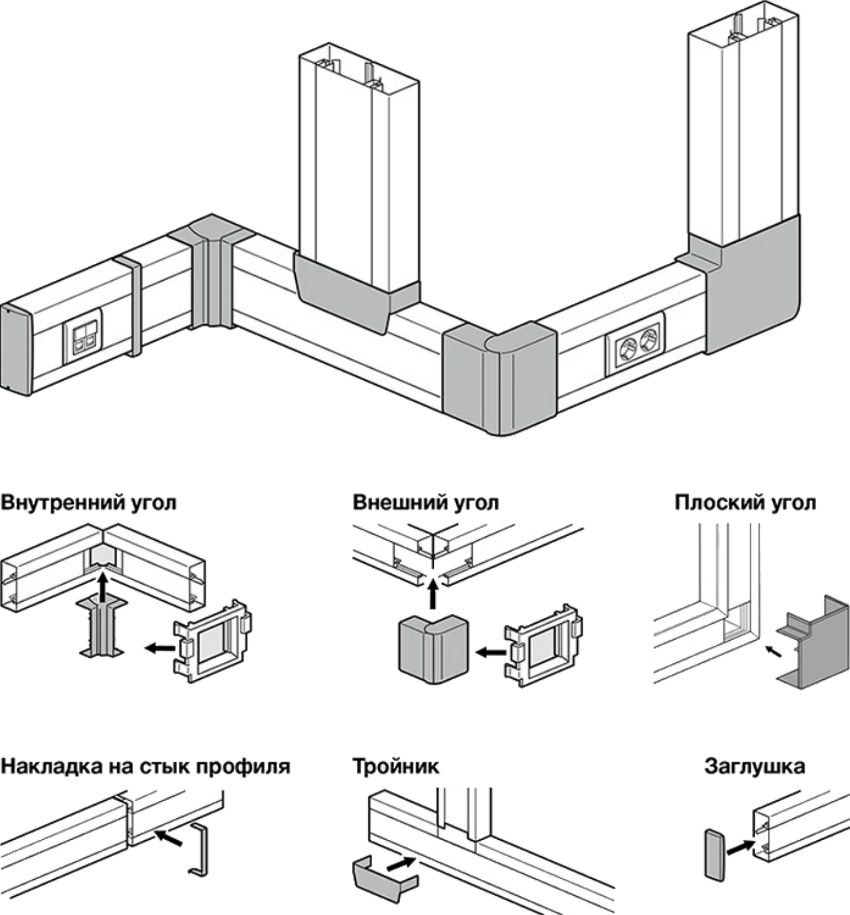
If any of the parts was damaged during installation, it can be purchased separately at any hardware store.
In the cable channels for electrical wiring you can lay the following types of wires:
- computer;
- power;
- television;
- telephone;
- low current (video surveillance and fire alarm).
The scope of application of structures, mainly plastic, extends to office and residential buildings, industrial and administrative facilities, medical and educational institutions, bathhouses and entertainment complexes.
The advantages of wiring in the cable channel:
- Durable result.
- Safety and practicality.
- Protection of wiring against mechanical and chemical damage, as well as the influence of moisture and temperatures.
- Aesthetically appealing look.
- Efficiency.
- Quick access to wiring.
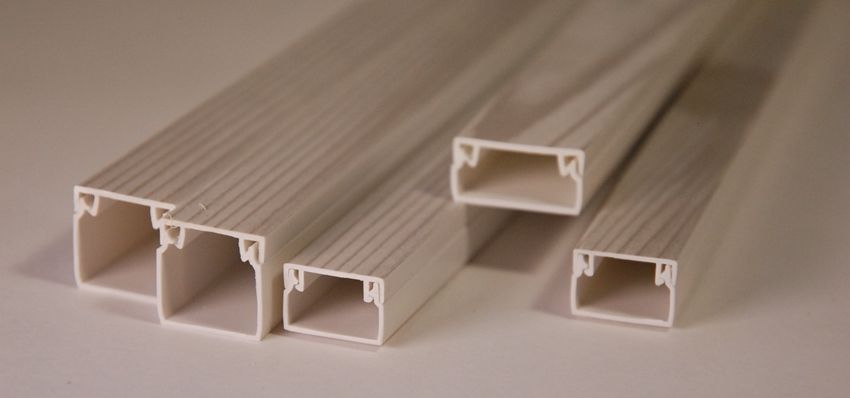
Helpful advice! When choosing designs you need to pay attention to the quality of the slots and fasteners. The durability of the box depends on it, because during operation the product will be subjected to constant loads.
Metal structures are considered higher quality than plastic boxes for electrical wiring. For their manufacture, manufacturers use two types of material: galvanized steel and anodized aluminum. Such products are able to withstand heavy loads.
Products made of galvanized steel have refractory properties. They are used for installation of warning systems and video surveillance. Steel boxes protect wires from mechanical damage and the effects of electromagnetic radiation. The price of these products is much higher than plastic. The cost of a galvanized cable channel 60×40 mm with a length of 2 m (manufacturer of OBO Bettermann) is 1175 rubles / pcs.
Boxes made of anodized aluminum do not transmit electromagnetic radiation to the wiring. This type of material is resistant to fire and mechanical stress, it is practical and durable. The purchase of an aluminum mini-channel 65×40 mm per section (manufacturer SIMON) will cost 3500 rubles / piece.
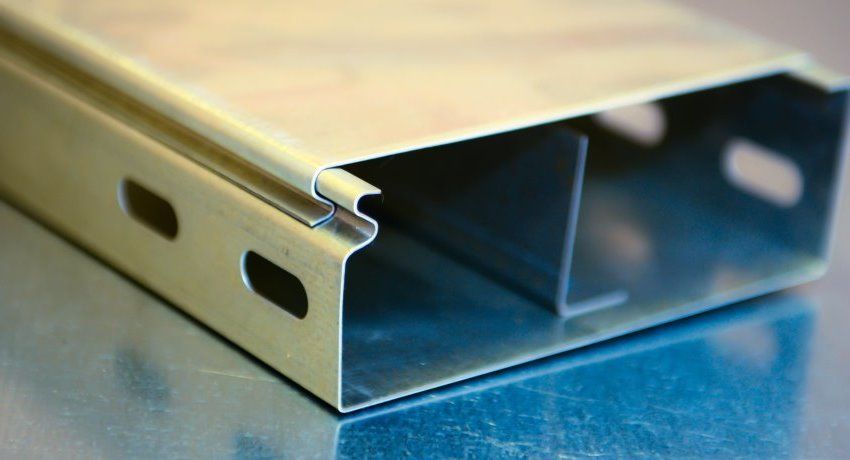
The advantages of metal products:
- simple installation system;
- high level of fire safety;
- large selection of colors;
- the presence of the cover, complete with a reliable latch.
In addition, the steel box has a high impact resistance, resistance to the effects of temperature fluctuations and direct sunlight.
Plastic conduit boxes are in high demand. These designs can have a square, triangular or rectangular section. In the assortment of modern stores you can find plastic products of any type and size, cable channels of this type can perform a protective function and at the same time act as decorative masking for wires.
Advantages of plastic boxes:
- lightweight construction weight;
- resistance to corrosive effects;
- simple fixation system;
- for installation of a cover use of the tool is not required;
- affordable cost;
- high decorative properties of PVC cable channels allow using them in any interiors;
- special care is not required;
- the material lends itself well to cutting and allows to obtain segments of any length;
- does not undergo deformational changes due to temperature jumps.

Note! In rooms where there is a high probability of fire, it is not recommended to use PVC cable channels. In this case, it is better to give preference to metal products.
Cable channels differ from each other not only by the material of manufacture, but also by the configuration, as well as size. On sale there are unusual products, for example, from alloys of aluminum or transparent plastic.
Main types of cable channels:
- baseboards;
- parapet;
- floor standing;
- mini designs;
- angular type;
- for mounting LED strips;
- trays from metal.
All of them have a specific purpose, have their own characteristics and dimensional ruler.
If you want to secretly lay the electrical wiring in the room, it is better to use plinth products. Inside these structures there are cavities where the cable is laid. Products are available in different colors, so consumers can choose the right option for any design and style of the room.
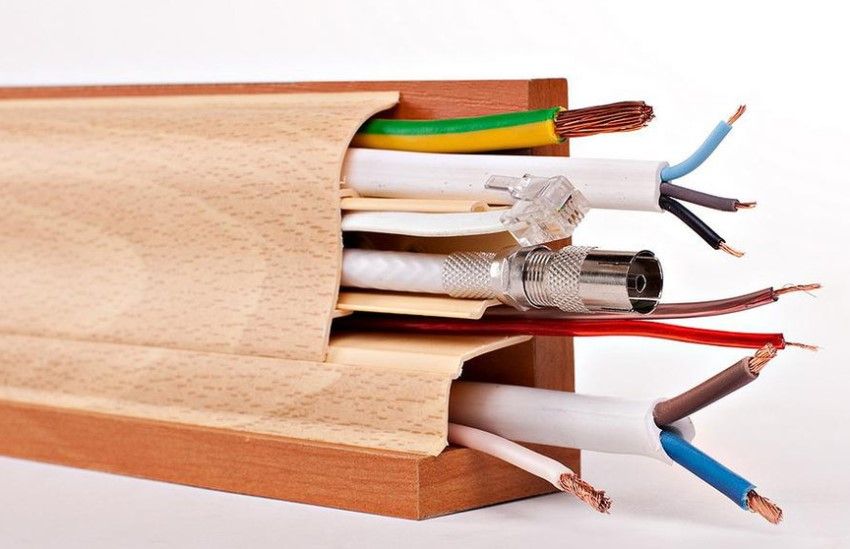
These products are very convenient and practical. On sale you can find not only the whole system of baseboard boxes, but also additional devices that are used to assemble structures of any configuration.
These devices include:
- elbows of various shapes;
- inside corners;
- outside corners;
- junction boxes (100x100x50 mm and other sizes);
- multi-module boxes, etc.
All these devices are designed to install the outlet in the cable channel or switch. In addition, additional devices allow the installation of these elements directly at the level of the plinth. Due to this, switches and sockets will not be very noticeable and attract attention, although this option is not suitable for older people who can not bend over low.
Plinth boxes are available in different colors:
- black;
- white;
- gray
- imitation of various materials, such as metal or wood.
Dimension lines and standard depend solely on the manufacturer. Consumers can order partitions, caps, cable channels and other devices of various dimensions from Legrand.
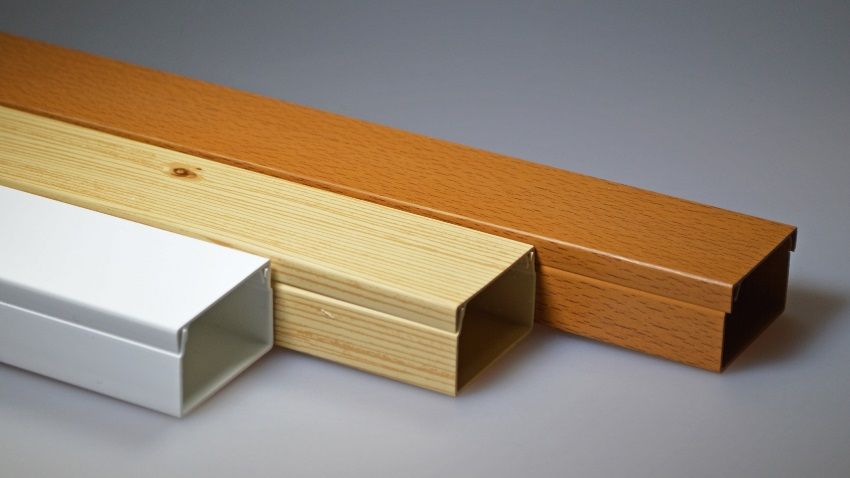
Boxes of this brand are presented in two series:
- Mini – 12.5×20 mm, 12.5×32 mm, 12.5×40 mm, 66×32 mm, 16×40 mm. In addition, this series includes cable channels 60×60 mm, 20×75 mm and 20×60 mm.
- DPL – 80×35 mm, 105×35 mm, 150×50 mm, 105×50 mm, 80×50 mm and 150×60 mm.
Note! Skirting with a cable channel allows you to abandon the shtenbleniya walls during the laying of electrical wiring. Thus, the installation work is greatly simplified. In addition, there is no need to use specialized tools, to clean construction debris and rebuild walls.
This type of box differs not only in its shape, but also in its installation method. One side of the product is flat, and the second is rounded. Thanks to this, the floor-mounted product looks harmonious and does not create interference. For the production of floor cable channels, manufacturers use aluminum and plastic with impact-resistant properties.
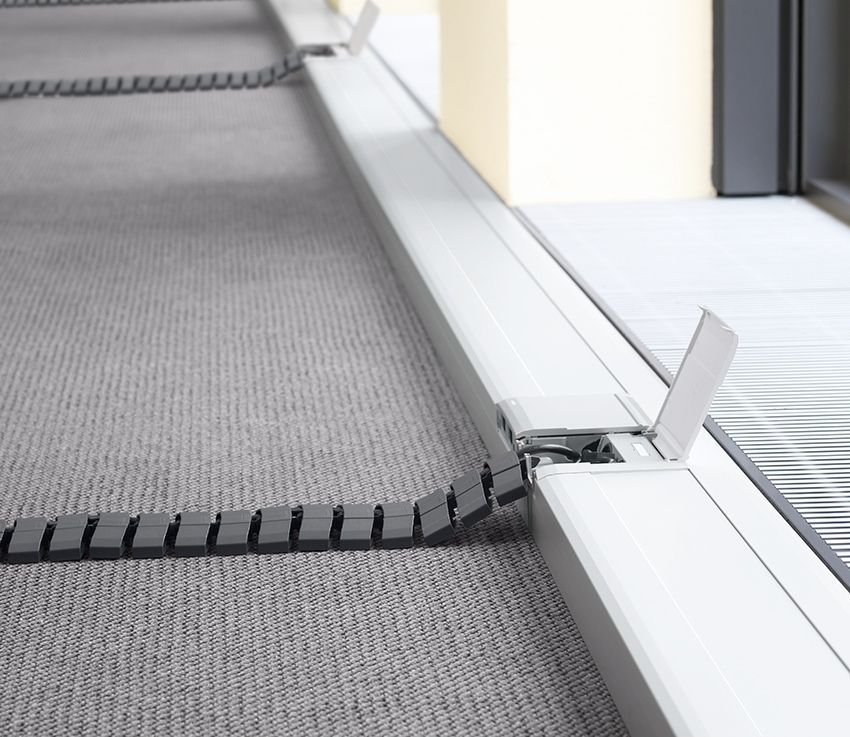
Floor trays for cables are used as part of the overall system. They are necessary in cases where you want to lead the wiring to the lighting device or table, which is located far from the walls. This type of product can be a complete replacement for carriers and extension cords.
The most common sizes of floor boxes:
- 17×75 mm;
- 12×50 mm;
- 65×160 mm;
- 20×92 mm.
The colors of these designs are not so diverse and include white, black and gray shades. For the design of the joints between the two strips, shaped products of the appropriate size are used. First, the installation of the lower part. After that, the cables are laid, and the design is closed with a lid.
Some manufacturers offer practical accessories that enhance the quality and reliability of the system. For example, the cable channels Legrand are completed with such details as joints and corners. These elements have a special design, thanks to which it is enough just to snap them in order to secure the construction of the structure. At the same time the product provides a high degree of protection. Most often it reaches the level of IP40.
Parapet boxes have another name – trunk. Their configuration is in many respects similar to the structure of baseboards cable channels. The differences are primarily related to the installation method, since parapet products are installed above the level of the floors. These systems include many elements that allow you to create a design of any shape.
Most often trunk boxes are installed in enterprises and offices. Installation is also possible in residential premises (apartments, private houses), but in this case it is advisable to select the colors of the products to match the wall decoration. The color scheme includes several options, but the main tones remain milky and white. You can find other shades, but it is quite difficult. Common dimensions of cable channels: 100×60 mm, 80×40 mm, 150×60 mm and 120×55 mm.
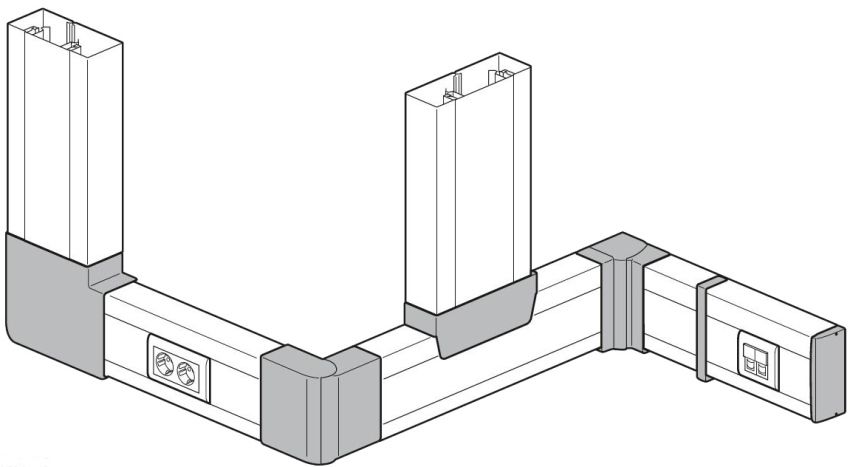
Under each type of section you can choose the necessary fittings:
- caps;
- outside corners;
- inside corners;
- splitters.
Helpful advice! Parapet trays can be used to mask the routes connecting the indoor and outdoor units of air conditioning systems. They are perfect for this purpose.
Characteristic and dimensional ruler mini cable channels: 25×16 mm, 10×10 mm and other sizes
There is a smaller version of the parapet boxes – mini-designs. They are designed for laying a certain number of wires, as a rule, television, telephone and cables for the Internet. The smallest dimensions of these cable channels: 10×15 mm and 10×10 mm.
When using such small structures, no shaped elements are used to design the corner pieces. To do this, cut down the cable channel at the required angle. In most cases, cuts are made at 45 °. It should take into account the placement of the angle, which can be external or internal.
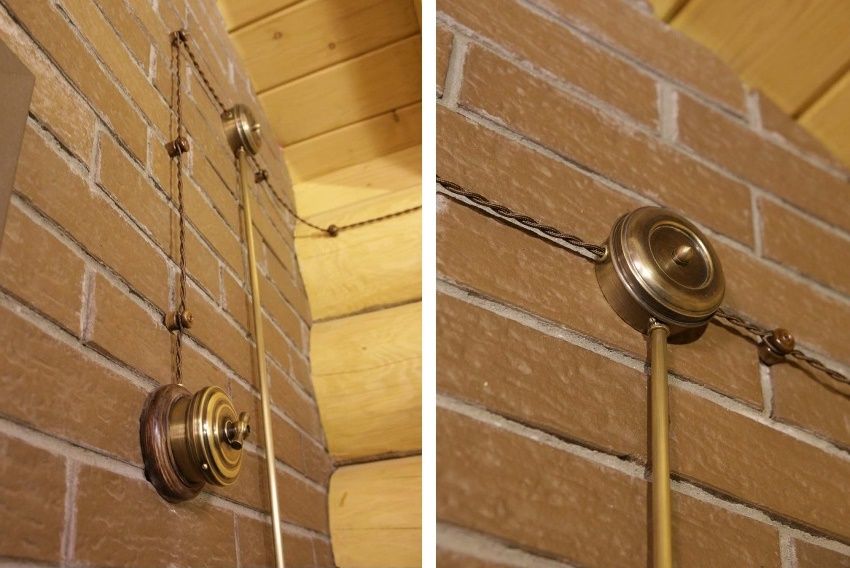
The offer of the modern market allows you to choose a box for cables with any characteristics and design. In order not to be mistaken with the choice of parts for laying electrical wiring in the house, it is necessary to take into account all factors, including the size of structures, manufacturer, decorative qualities and purpose. Properly selected boxes not only mask unattractive cables indoors, but can complement any modern interior.

